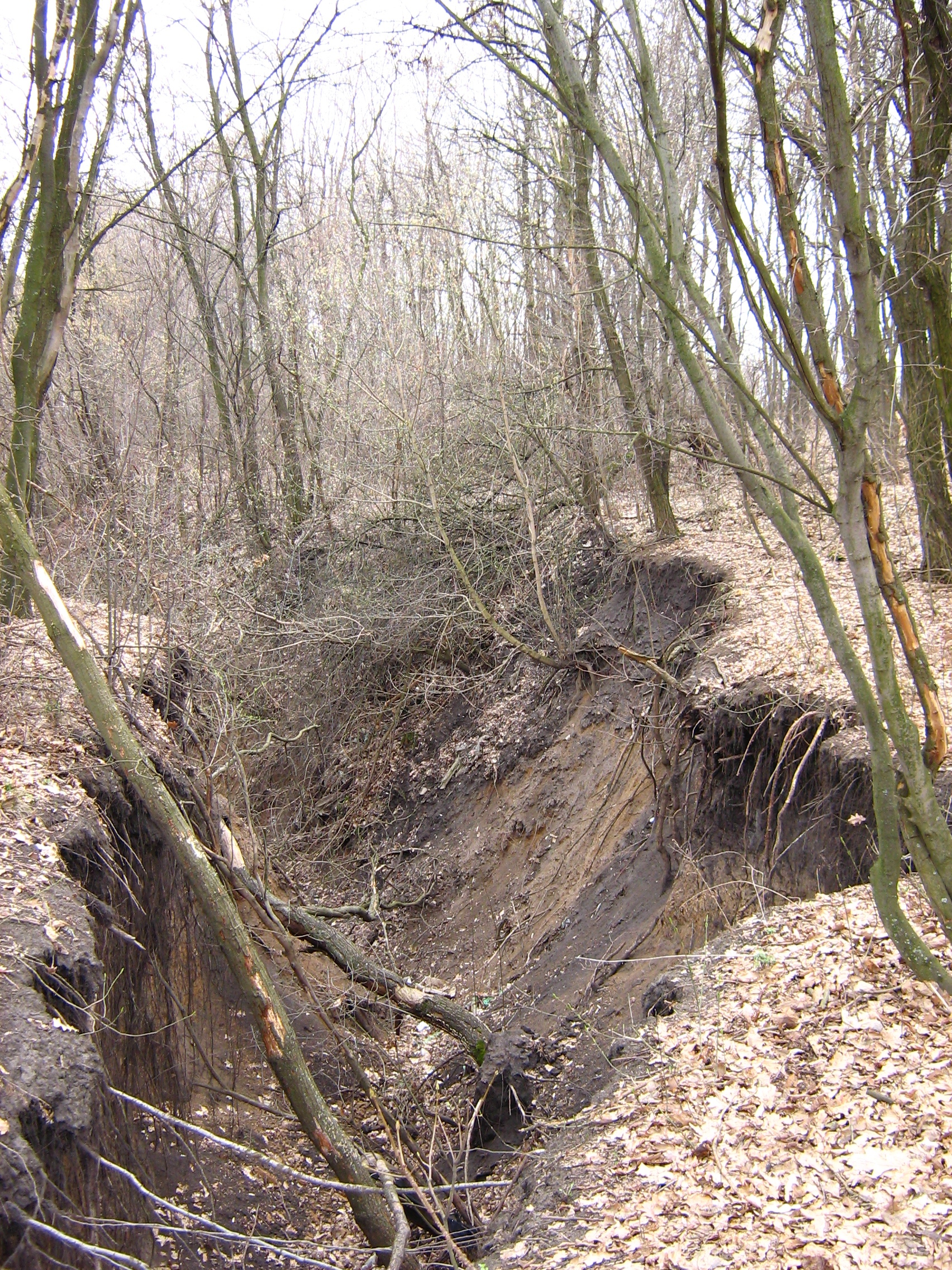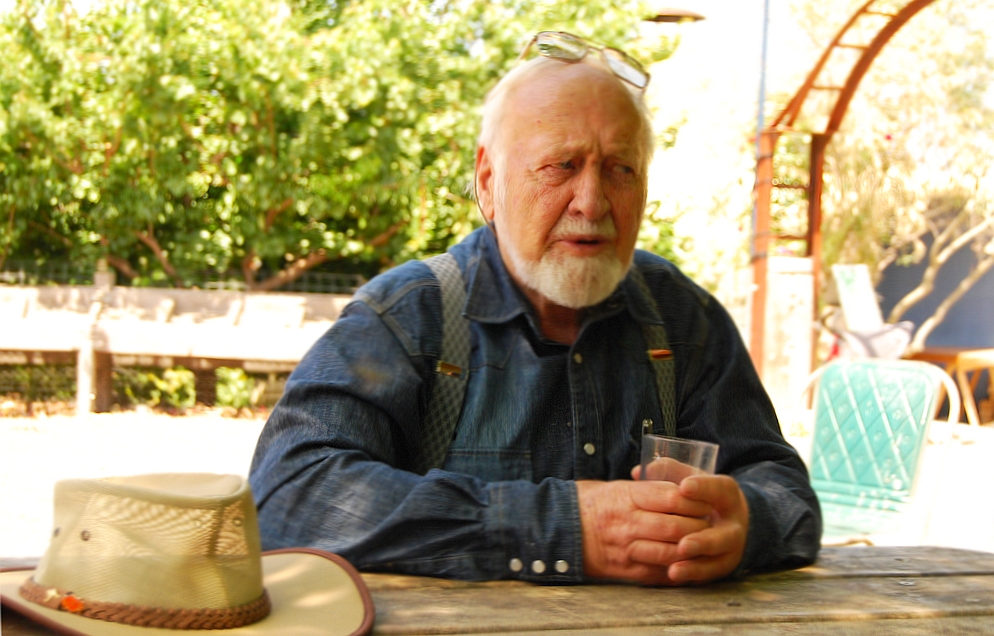|
Grassed Waterway
A grassed waterway is a to 48-metre-wide (157 ft) native grassland strip of green belt. It is generally installed in the thalweg, the deepest continuous line along a valley or watercourse, of a cultivated dry valley in order to control erosion. A study carried out on a grassed waterway during 8 years in Bavaria showed that it can lead to several other types of positive impacts, e.g. on biodiversity. Distinctions Confusion between "grassed waterway" and "vegetative filter strips" should be avoided. The latter are generally narrower (only a few metres wide) and rather installed along rivers as well as along or within cultivated fields. However, buffer strip can be a synonym, with shrubs and trees added to the plant component, as does a riparian zone. Runoff and erosion mitigation Runoff generated on cropland during storms or long winter rains concentrates in the thalweg where it can lead to rill or gully erosion. Rills and gullies further concentrate runoff and speed up it ... [...More Info...] [...Related Items...] OR: [Wikipedia] [Google] [Baidu] |
Gully
A gully is a landform created by running water, mass movement, or commonly a combination of both eroding sharply into soil or other relatively erodible material, typically on a hillside or in river floodplains or terraces. Gullies resemble large ditches or small valleys, but are metres to tens of metres in depth and width and are characterised by a distinct 'headscarp' or 'headwall' and progress by headward (i.e. upstream) erosion. Gullies are commonly related to intermittent or ephemeral water flow usually associated with localised intense or protracted rainfall events, or snowmelt. Gullies can be formed and accelerated by cultivation practices on hillslopes (often gentle gradient) in farmland, and they can develop rapidly in rangelands from existing natural erosion forms subject to vegetative cover removal and livestock activity. Etymology The earliest known usage of the term is from 1657. It originates from the French word ''goulet'', a diminutive form of ''goule'' which m ... [...More Info...] [...Related Items...] OR: [Wikipedia] [Google] [Baidu] |
Sustainable Agriculture
Sustainable agriculture is farming in sustainable ways meeting society's present food and textile needs, without compromising the ability for current or future generations to meet their needs. It can be based on an understanding of ecosystem services. There are many methods to increase the sustainability of agriculture. When developing agriculture within sustainable food systems, it is important to develop flexible business process and farming practices. Agriculture has an enormous environmental footprint, playing a significant role in causing climate change (food systems are responsible for one third of the anthropogenic GHG emissions), water scarcity, water pollution, land degradation, deforestation and other processes; it is simultaneously causing environmental changes and being impacted by these changes. Sustainable agriculture consists of environment friendly methods of farming that allow the production of crops or livestock without damage to human or natural systems. It ... [...More Info...] [...Related Items...] OR: [Wikipedia] [Google] [Baidu] |
Permaculture
Permaculture is an approach to land management and settlement design that adopts arrangements observed in flourishing natural ecosystems. It includes a set of design principles derived using whole-systems thinking. It applies these principles in fields such as regenerative agriculture, town planning, rewilding, and community resilience. Permaculture originally came from "permanent agriculture", but was later adjusted to mean "permanent culture", incorporating social aspects. The term was coined in 1978 by Bill Mollison and David Holmgren, who formulated the concept in opposition to modern industrialized methods instead adopting a more traditional or "natural" approach to agriculture. Permaculture has many branches including ecological design, ecological engineering, regenerative design, environmental design, and construction. It also includes integrated water resources management, sustainable architecture, and regenerative and self-maintained habitat and agricultural system ... [...More Info...] [...Related Items...] OR: [Wikipedia] [Google] [Baidu] |
Landscape
A landscape is the visible features of an area of land, its landforms, and how they integrate with natural or man-made features, often considered in terms of their aesthetic appeal.''New Oxford American Dictionary''. A landscape includes the physical elements of geophysically defined landforms such as (ice-capped) mountains, hills, water bodies such as rivers, lakes, ponds and the sea, living elements of land cover including indigenous vegetation, human elements including different forms of land use, buildings, and structures, and transitory elements such as lighting and weather conditions. Combining both their physical origins and the cultural overlay of human presence, often created over millennia, landscapes reflect a living synthesis of people and place that is vital to local and national identity. The character of a landscape helps define the self-image of the people who inhabit it and a sense of place that differentiates one region from other regions. It is the dyn ... [...More Info...] [...Related Items...] OR: [Wikipedia] [Google] [Baidu] |
Habitat
In ecology, the term habitat summarises the array of resources, physical and biotic factors that are present in an area, such as to support the survival and reproduction of a particular species. A species habitat can be seen as the physical manifestation of its ecological niche. Thus "habitat" is a species-specific term, fundamentally different from concepts such as environment or vegetation assemblages, for which the term "habitat-type" is more appropriate. The physical factors may include (for example): soil, moisture, range of temperature, and light intensity. Biotic factors will include the availability of food and the presence or absence of predators. Every species has particular habitat requirements, with habitat generalist species able to thrive in a wide array of environmental conditions while habitat specialist species requiring a very limited set of factors to survive. The habitat of a species is not necessarily found in a geographical area, it can be the interior ... [...More Info...] [...Related Items...] OR: [Wikipedia] [Google] [Baidu] |
Habitats
In ecology, the term habitat summarises the array of resources, physical and biotic factors that are present in an area, such as to support the survival and reproduction of a particular species. A species habitat can be seen as the physical manifestation of its ecological niche. Thus "habitat" is a species-specific term, fundamentally different from concepts such as environment or vegetation assemblages, for which the term "habitat-type" is more appropriate. The physical factors may include (for example): soil, moisture, range of temperature, and light intensity. Biotic factors will include the availability of food and the presence or absence of predators. Every species has particular habitat requirements, with habitat generalist species able to thrive in a wide array of environmental conditions while habitat specialist species requiring a very limited set of factors to survive. The habitat of a species is not necessarily found in a geographical area, it can be the interior ... [...More Info...] [...Related Items...] OR: [Wikipedia] [Google] [Baidu] |
Ecological Restoration
Restoration ecology is the scientific study supporting the practice of ecological restoration, which is the practice of renewing and restoring degraded, damaged, or destroyed ecosystems and habitats in the environment by active human interruption and action. Effective restoration requires an explicit goal or policy, preferably an unambiguous one that is articulated, accepted, and codified. Restoration goals reflect societal choices from among competing policy priorities, but extracting such goals is typically contentious and politically challenging. Natural ecosystems provide ecosystem services in the form of resources such as food, fuel, and timber; the purification of air and water; the detoxification and decomposition of wastes; the regulation of climate; the regeneration of soil fertility; and the pollination of crops. These ecosystem processes have been estimated to be worth trillions of dollars annually. There is consensus in the scientific community that the current envi ... [...More Info...] [...Related Items...] OR: [Wikipedia] [Google] [Baidu] |
Hydraulic Engineering
Hydraulic engineering as a sub-discipline of civil engineering is concerned with the flow and conveyance of fluids, principally water and sewage. One feature of these systems is the extensive use of gravity as the motive force to cause the movement of the fluids. This area of civil engineering is intimately related to the design of bridges, dams, channels, canals, and levees, and to both sanitary and environmental engineering. Hydraulic engineering is the application of the principles of fluid mechanics to problems dealing with the collection, storage, control, transport, regulation, measurement, and use of water.Prasuhn, Alan L. ''Fundamentals of Hydraulic Engineering''. Holt, Rinehart, and Winston: New York, 1987. Before beginning a hydraulic engineering project, one must figure out how much water is involved. The hydraulic engineer is concerned with the transport of sediment by the river, the interaction of the water with its alluvial boundary, and the occurrence of scour an ... [...More Info...] [...Related Items...] OR: [Wikipedia] [Google] [Baidu] |
Environmental Soil Science
Environmental soil science is the study of the interaction of humans with the pedosphere as well as critical aspects of the biosphere, the lithosphere, the hydrosphere, and the atmosphere. Environmental soil science addresses both the fundamental and applied aspects of the field including: buffers and surface water quality, vadose zone functions, septic drain field site assessment and function, land treatment of wastewater, stormwater, erosion control, soil contamination with metals and pesticides, remediation of contaminated soils, restoration of wetlands, soil degradation, nutrient management, movement of viruses and bacteria in soils and waters, bioremediation, application of molecular biology and genetic engineering to development of soil microbes that can degrade hazardous pollutants, land use, global warming, acid rain, and the study of anthropogenic soils, such as terra preta. Much of the research done in environmental soil science is produced through the use of models ... [...More Info...] [...Related Items...] OR: [Wikipedia] [Google] [Baidu] |
Environmental Engineering
Environmental engineering is a professional engineering discipline that encompasses broad scientific topics like chemistry, biology, ecology, geology, hydraulics, hydrology, microbiology, and mathematics to create solutions that will protect and also improve the health of living organisms and improve the quality of the environment. Environmental engineering is a sub-discipline of civil engineering and chemical engineering. While on the part of civil engineering, the Environmental Engineering is focused mainly on Sanitary Engineering. Environmental engineering is the application of scientific and engineering principles to improve and maintain the environment to: * protect human health, *protect nature's beneficial ecosystems, *and improve environmental-related enhancement of the quality of human life. Environmental engineers devise solutions for wastewater management, water and air pollution control, recycling, waste disposal, and public health. They design municipal water supply ... [...More Info...] [...Related Items...] OR: [Wikipedia] [Google] [Baidu] |
Sustainable Design
Environmentally sustainable design (also called environmentally conscious design, eco-design, etc.) is the philosophy of designing physical objects, the built environment, and services to comply with the principles of ecological sustainability and also aimed at improving the health and comfortability of occupants in a building.McLennan, J. F. (2004), The Philosophy of Sustainable Design Sustainable design seeks to reduce negative impacts on the environment, the health and well-being of building occupants, thereby improving building performance. The basic objectives of sustainability are to reduce the consumption of non-renewable resources, minimize waste, and create healthy, productive environments. Theory The sustainable design intends to "eliminate negative environmental impact through skillful sensitive design". Manifestations of sustainable design require renewable resources and innovation to impact the environment minimally, and connect people with the natural environment. ... [...More Info...] [...Related Items...] OR: [Wikipedia] [Google] [Baidu] |






